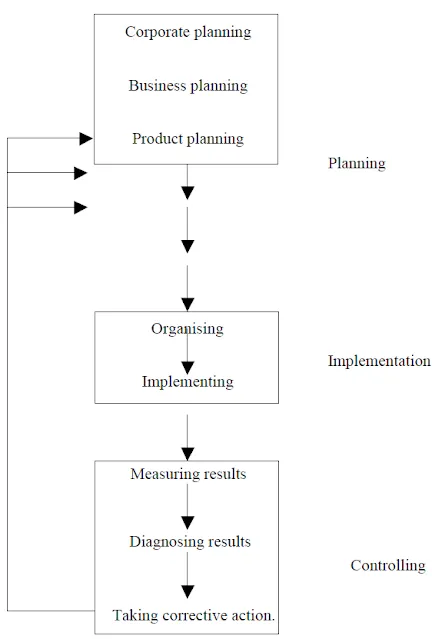This article talks about strategic planning in an organisation. This was devised by corporate leaders to implement strategies that will enhance the competitiveness of each business unit. It differs from the yearly fiscal plans of the organisation.

Table of Contents
Background Information on Strategic Planning
Strategic planning (SP) evolved in the business world in the United States of America (USA) and was later adapted for non-profit making organisations such as hospitals and tertiary institutions such as the universities.
Strategic planning was embraced by corporate leaders in the mid-1960s to devise and implement strategies that would enhance the competitiveness of each business unit, generate decisions about deployment of resources toward fixed goals and priorities and build a sustainable long-term future with a constantly changing or dynamic environment.
Strategic planning cannot be prepared by an outside expert but rather a prescription that is formulated by the combined expertise within the organisation. The purpose ofplanning is to make decisions about the future before the future either forces the decisions on us or renders any decision irrelevant.
The essence of strategic planning is the identification of specific desired results to which all the efforts and activities of the organisation will be dedicated. The success of any plan is determined only by the results its produces.
Meaning of Strategic Planning
Strategic planning differs significantly from yearly fiscal plans. Cope (1981) clearly identifies and states the differences as follows:
a. Strategic planning focuses on the process while the long-term planning with its application of formulae, gives little attention tothe organisation’s politics and the changing circumstances.
b. Strategic planning pays attention to the external environment, qualitative information and initiative decisions regarding resource commitment and integrated participatory involvement. Long-term planning tends towards internal analysis and qualitative modelsof resources deployment, and itconducted as aseparateinstitutional function.
c.Long-term planning emphasises the science of planning withdetailed and interfaced sets of data. The strategicview emphasises creativity, innovativeness and methods to maneuver the institution over time and across turbulent waters.
d. Long-term planning focuses on organisational goals andobjectives for at least five years ahead while strategic planningasks what decision is appropriate today based upon an understanding of where the critical external variables will be five years from now.
Therefore, strategic planning has been described as the process of setting organisational goals or objectives based on identified strengths and weaknesses.
Development of Strategic Planning
Many things have been written about strategic planning. However,strategic planning as a discipline with its associated concepts and techniques only emerged fully in the early 1970s. There are, of course, many reasons for this. In the words of Kotler (1988), it was largely because of the growing and continuously buoyant markets of the 1950s and 1960s when many companies prospered on the back of largely short-term operational planning.
The turbulence of the early 1970s that followed a series of crises, including oil supply restrictions, energyEnergy is the property of matter and radiation which is mani... More and materialMaterial or Matter is anything which has mass and occupies s... More shortages, high inflation, economic stagnation, labour unrest, increased unemployment and then recession caused many major reasons to search for a radically different approach to the running of their businesses. These were compiled with influx of low-price but relatively high-quality products from countries like Japan which began to flood the western markets. These products changed rapidly and drastically the economics of manufacturing industries.
The revised approach to management planning threats that emerged was then designed to provide the organisation with a far stronger and more resilient framework that would enable managers to recognise the opportunities more readily and overcome threats more easily.
Thismarks the beginning of a new planning process to take maximum advantage of opportunities and threats in the environment. It also entails a consideration of strategic alternatives and a choice of the most appropriate strategyA strategy is a plan that integrates an organisation's major... More towards achieving set goals or objectives. This is in addition to periodic evaluation to ensure that the chosen strategyA strategy is a plan that integrates an organisation's major... More would achieve the objectives; if not, to alter the strategyA strategy is a plan that integrates an organisation's major... More or review the objectives. Daniyan (2002) reiterates the definition which states that somebody defines strategic planning as “congruous and collective exercise of foresight and taking informed decisions about the future”.
Another simple way of looking at strategic planning is to consider it as a formal process of determining long-term objectives and how to achieve them.
In practice, strategic planning deals with five separate tasks, which are as follows:
(i)Determination of the long-term direction of the company.
(ii) Determination of the resources requirement of the company.
(iii) Establishing of overall goals and strategies.
(iv)Assessment of the competitive position of the firm in theindustry.
In a modern organization, strategic planning is seen as the focal point for all planning and reporting. It is closely linked to market studies, capital spending, contingency planning and annual profit plan or budget.
In the process of strategic planning are of three fundamental questions that needs to ask, which are
Where is our organisation now?
Where do we want the organisation to be? How do we get the organisation there?
These three basic questions must be objectively and sincerely answered for the strategic planning to achieve its desired objectives. It should be noted that both short-term and long-term strategies require planning.
Processes Involved n Strategic Planning
There are processes and methodologies involved in conducting strategic planning. The processes involve a step-by-step systematic approach, which starts out from the very beginning with focus on implementation. The standard methodology works for every organisation whether big or small. However, industry variations and adaptations need to be made. Such various include the following:
Competitive Analysis
Organisations that enjoy monopoly of their business, e.g. PowerPower in physics is the rate of doing work; measured in watt... More Holding Corporation of Zambia (PHCZ), will certainly omit a step since it has no competitor.
Planning Horizon
Some organisations may need to plan for a long time to come especially in trading activities (e.g. PHCZ) while others may not need more than a year”s planning.
Functional Analysis
Consumer products companies are very much marketing-oriented.
Such companies must be serious to consider the market for their products in the strategic planning.
Regulatory Analysis
In this aspect, some industries or businesses are more affected than the others. For instance, tobacco companies and alcohol producing companies are more affected than the soft drinks producing companies.
Technological Trends
Certainly, technological advancement vary vividly between the advanced and the developing countries. This will affect the activities of the organisation. The technology must be of concern particularly to the local industries.
Economic Sensitivity
The local companies may be less sensitive than the importers.
Changing Focus of Strategic Planning
At the beginning of the 1990s, a number of researchers including Stacey (1991) and Mintzberg (1994) began questioning the traditional and well established line of thinking about strategic planning. With its origin in late 1960s and early 1970s, strategic planning had been held by many as the most logical and effective way of devising and implementing the strategies which would improve the competitiveness of a business unit.
However, Mintzberg argues that the creation in many large organisation of specialist departments, staffed with strategic planners who are involved in the thinking but not in doing or the implementation, has created a series of difficulties and tensions. The net effect, according to him, is that strategic planning has long since fallen from its pedestal. He goes on to say that:
But even now few people really understand the reason: strategicplanning is not strategic thinking. Indeed strategic planning often spoils strategic thinking, causing managers to confuse real vision with the manipulation of numbers. And this confusion lies at heart of the issue: the most successful strategies are reasons notplans.
Mintzberg, in making this assertion, highlights the way in which strategic planning is indeed strategic programming, an activity which involves articulating strategies or visions which already exist. He believes managers should understand the differences between planning and strategic thinking so that they can focus upon what the development process should really be.
This implies that the role of the planner changes significantly. ForMintzberg, the planner’s contribution should be around rather than inside the strategy-making process. The planner should provide the analysis and data inputs that the strategic thinker needs and not the one supposedly correct answer to the strategic challenge being faced.This redefinition of roles illustrates, in turn, the distinction that needs to be made between the analytical dimension of planning and the synthesis, intuition and creativity that characterise true strategic thinking.
Stacey, in his own criticism of the traditional logical and sequential approach of planning, argues for a managerial emphasis upon adaptability, intuition, paradox and entrepreneurial creativity in order to cope with an unpredictable and inherently unknowable future. Staceyhighlights the importance of intuition and the need for managers to deal with problems in a truly holistic fashion. He goes on to suggest that managers must learn to reason through induction rather than deduction, and to argue by analogy, to think in metaphor and to accept paradox.Both Mintzberg and Stacey argue for a greater creativity within the organisation.
Stacey’s views rest upon the idea that, because of the nature and complexity of the business system, anything useful about the future is essentially unknowable, something which negates the value of the conventional planning. Wisdom that success depends upon developing a vision of where the company wants to be in five, ten or twenty years time, the strategyA strategy is a plan that integrates an organisation's major... More that will achieve this and a shared culture.
Stacey believes that real strategyA strategy is a plan that integrates an organisation's major... More emerges from group dynamicsDynamics is the branch of mechanics concerned with the force... More, from politicking and informal lobbying in the corridors, from the complicated patterns of relationships and interplay of personalities, from pressure groups that spring up after the formal meetings; that real success lies notin total stability and “sticking to your knitting” but in the tensionbetween stability (in the day-to-day running of the business) and instability (in challenging the status quo). Instability is not just due to ignorance or incompetence; it is a fundamental part of successful business firms (Stacey, 1994).
Strategic Planning and Responsibility
The ultimate responsibility of the planning process rests firmly with the corporate management. In practice, organisations differ greatly both in how they go about this and in the degree of freedom given to the managers or individual business units. For instance, some organisations allow business units considerable scope in developing their own objectives and strategies, ensuring only that the promised levels of performance are obtained. This is referred to bottom-up planning. By contrast, others are opposed to this, in that they establish the objectives and they insist on being involved in the development andimplementation of the strategy. This is known as the top-downplanning. Yet, others establish the goals and then leave the business units to develop the strategic for their achievement. This is called goals down-plans up planning.

Irrespective of the strategic planning approach that is adopted by the organisation, the corporate management has the ultimate responsibility for the four major dimensions of planning, which are:
a. Defining of the business mission
b. Establishing the company”s business units (SBU”s)


